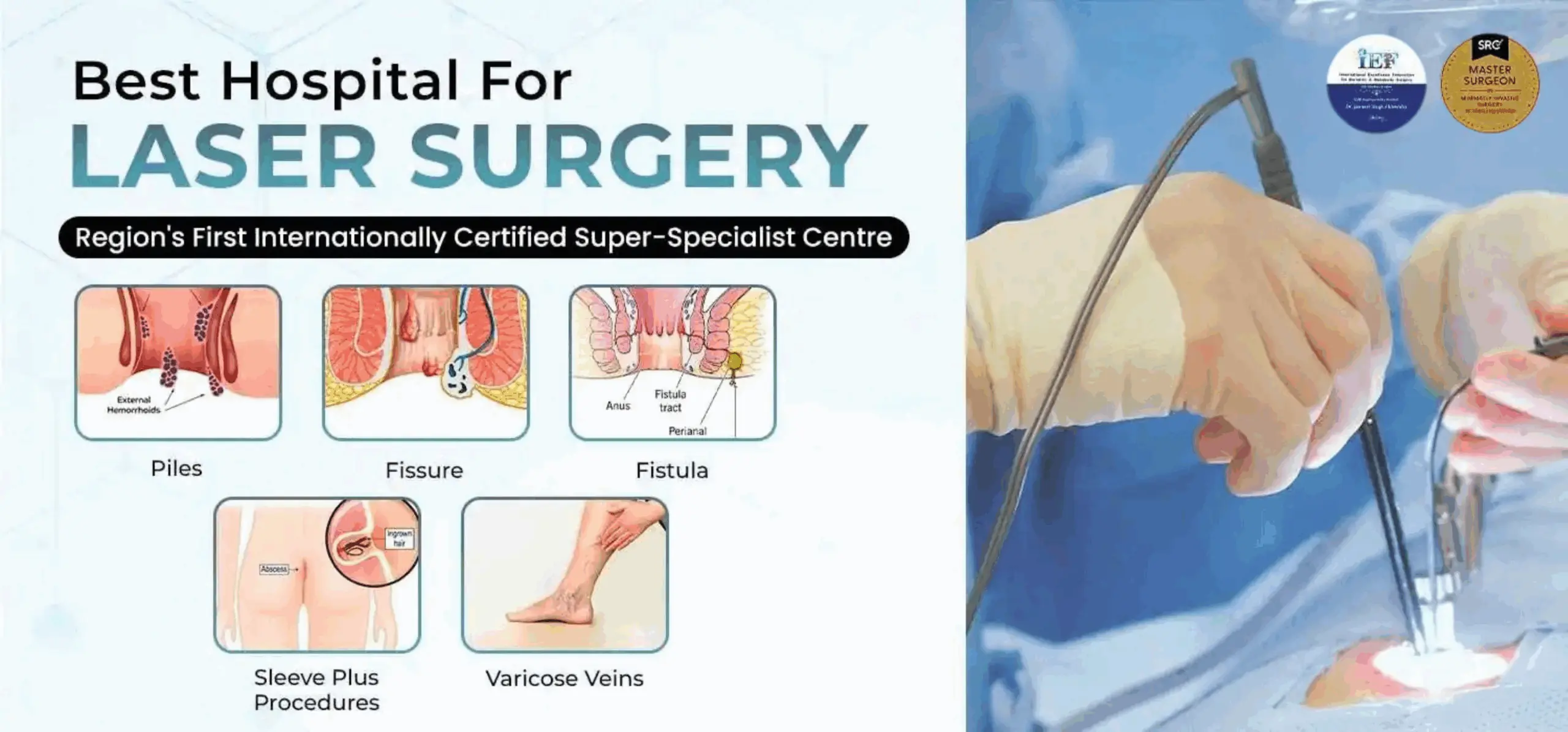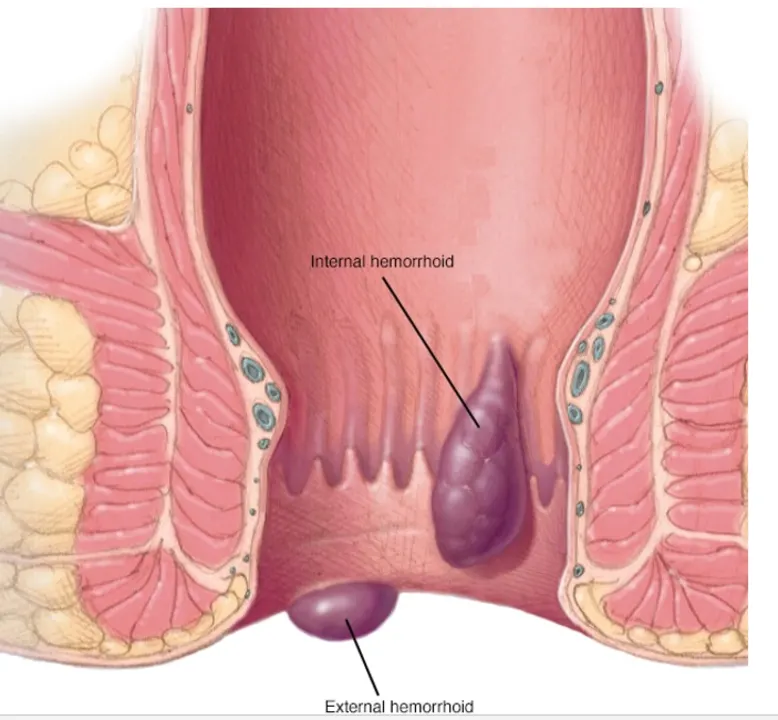
Stapler Surgery For Piles in Jalandhar
Piles Laser Treatment in Jalandhar is the most efficient way to make the treatment to be painless. There will be no cuts or stitches and the procedure takes about 30 minutes. You will be discharged in just one day of treatment.
Stapler Surgery For Piles in Jalandhar is a Prolapse & Hemorrhoids (PPH) technique to remove the problem of piles. After this treatment, you can join your work in just 2 days. We provide personalized care and the best medical quality service. You can get relief from the problem in just one day
Hemorrhoids (know as “Piles” commonly) are nothing but enlarged veins in anus and or lower rectum.
- Internal Hemorrhoids: When they develop inside the rectum
- External Hemorrhoids: When they develop under the skin around anus
Haemorrhoids is a very common condition and fortunately is not a difficult condition to treat.
Call +91 98889-58889 For A Enquiry.


Symptoms
External hemorrhoids
- Bleeding – Fresh blood usually while or after passing stools. May be painful or painless
- Swelling around anal area
- Itching
- Pain or discomfort
Internal hemorrhoids
- Painless fresh bleeding while passing stools.
- If they become very big, they may come out of anal opening.
Thrombosed hemorrhoids
This means blood clot has formed in external piles. It results in:
- Severe painful swelling at rim of anus
Neat & Clean Rooms
Spotlessly clean, profoundly caring. Our hospital ensures a pristine environment for your well-being
Modern Equiments
Our hospital has advanced technology gadgets and the best equipment in every field.
City Centre Location
Conveniently located at the heart of the city, our hospital offers easy access and exceptional care in a prime city center location

Cause
Exact cause may not be apparent in every patient but some of the possible causes are:
- Prolonged diarrhea or constipation
- Straining while passing stools
- Obesity
- Pregnancy
- Eating a low-fiber diet
- Advanced age
Piles Educational Videos
Complications
Left untreated, piles can lead to:
- Anaemia
- Strangulated hemorrhoid.If the blood supply to an internal hemorrhoid is cut off, the hemorrhoid may be “strangulated,” which can cause extreme pain
- Blood clot – Thrombosed haemorrhoid as described above
Prevention
The best way to prevent hemorrhoids is to keep your stools soft, so they pass easily. To prevent hemorrhoids and reduce symptoms of hemorrhoids, follow these tips:
- Pass stools as soon as you get an urge to do so – Do not wait
- Eat high-fiber foods
- Drink plenty of water
- Exercise
- Avoid prolonged sitting
Diagnosis
External hemorrhoids may be visible just by looking but for internal – doctor needs to see inside:
- Digital examination.But inserting finger inside.
- Proctoscopy-Because internal hemorrhoids are often too soft to feel a small instrumented is inserted to see them.
- Sigmoidoscopy or Colonoscopy – In some cases if there is a doubt of another disease being present as well.
Treatment
External hemorrhoid thrombectomy
If a painful blood clot (thrombosis) has formed within an external hemorrhoid, your doctor can remove the hemorrhoid, which can provide prompt relief. This procedure, done under local anesthesia, is most effective if done within 72 hours of developing a clot.
Minimally invasive procedures

For persistent bleeding or painful hemorrhoids treatment is indicated
Rubber band ligation.
Small rubber bands can be placed at the base of internal haemorrhoids to cut off their blood supply thereby making them shrink. Bands fall off within a week or two. This is a painless office procedure.
- Injection (sclerotherapy). A chemical is inserted into the haemorrhoid to shrink it. This method is now less popular as it is less effective than band ligation.
- Coagulation (infrared, laser or bipolar). Coagulation techniques use laser or infrared light or heat. They cause small, bleeding internal haemorrhoids to harden and shrink.
Surgical procedures
Only a small percentage of people with haemorrhoids require surgery. However, if other procedures haven’t been successful or you have large haemorrhoids, your doctor might recommend one of the following:
- Hemorrhoid removal (hemorrhoidectomy). Excessive tissue along with enlarged blood vessels is removed. This is the most complete way of treatment but leads to post operative discomfort which can be relieved with medication and a hot water bath.
- Hemorrhoid stapling. This procedure, called stapled hemorrhoidopexy, blocks blood flow to hemorrhoidal tissue. Since it is fired in non-pain sensitive tissue, it results in very little discomfort after surgery and blood loss is also less.
Transanal Hemorrhoidal Artery Ligation
It involves the use of a proctoscope that allows the insertion of a Doppler transducer through it. Arterial branches are identified using the Doppler device and ligated with an absorbable suture. In the case of grade III or IV haemorrhoids, a mastopexy is also performed to prevent prolapse.

Piles Patients Testimonials
Frequent Questions - FAQ's
The most common surgical method for treating hemorrhoids is open surgical hemorrhoidectomy. Hemorrhoidectomy, however, is linked to serious side effects such as discomfort, bleeding, and wound infection, all of which can lead to an extended hospital stay.
Wheat bran and shredded wheat, Whole wheat bread, pasta, and cereals also, and some fruits like Apples, Pears, etc are good for piles patients.
The majority of the time, piles symptoms are not dangerous. Usually, they go away on their own in a few days. A person suffering from piles may feel that they have the following symptoms: One may feel a firm, perhaps painful lump surrounding the anus.
EXCELLENTTrustindex verifies that the original source of the review is Google. Thank you doctor Mandeep Kaur. I had a Positive result after 2 weeks of my IUI I am so happy I was waiting for so long to concive and to see 2 lines on my pregnancy test but every time that was unsuccessful but this was my first try with IUI and that’s go successfully thank you so much. 😊😊Posted onTrustindex verifies that the original source of the review is Google. Great experience with Dr. Mandeep and staff of the hospital.Posted onTrustindex verifies that the original source of the review is Google. My experience is very goodPosted onTrustindex verifies that the original source of the review is Google. Great Staff With good facilitiesPosted onTrustindex verifies that the original source of the review is Google. Thank you so much Dr mandeep from the bottom of hearts for taking such good care. Because of your professionalism and great smiles, we felt like we were in good hands and that gave us peace of mind towards the big day.Posted onTrustindex verifies that the original source of the review is Google. I got my friend’s weight loss surgery done at Star Hospital. We were impressed by Dr Ahluwalia’s clarity of thought on weight loss and Bariatric Surgery. We visited some other hospitals before and were always confused as their versions were very different but here we got answers to all our questions in a very clear way and my friend could gather courage to finally get his Bariatric Surgery done and start living a normal life again. Procedure went smooth as was told and we were out out of hospital very next day. Now we regret delaying this for years!Posted onTrustindex verifies that the original source of the review is Google. Dr Mandeep is a very hardworking and nice doctor.my result came positive and I'm very thankful to mam and all the staff members 🙏🙏










